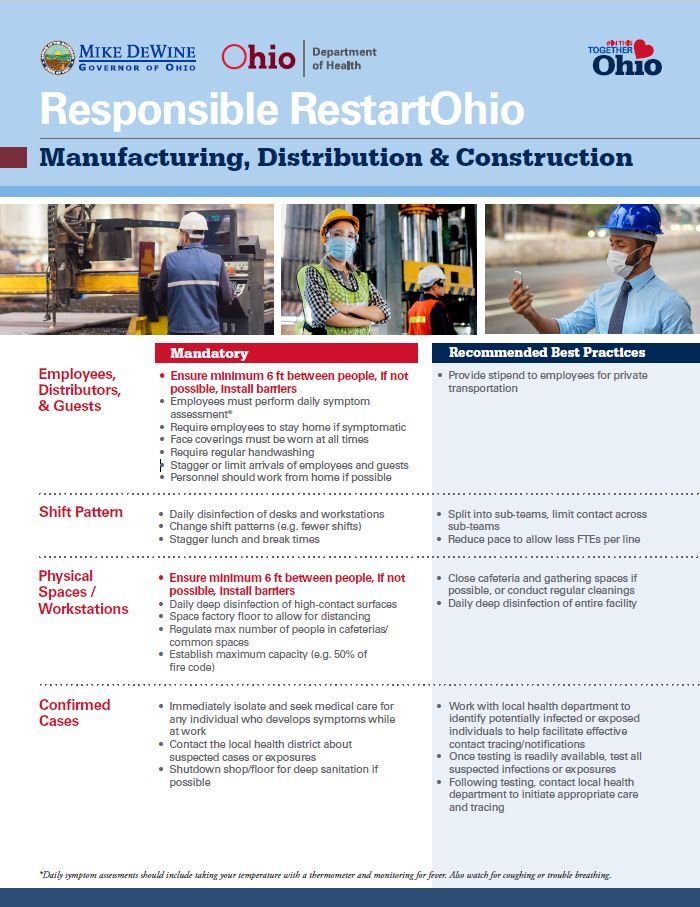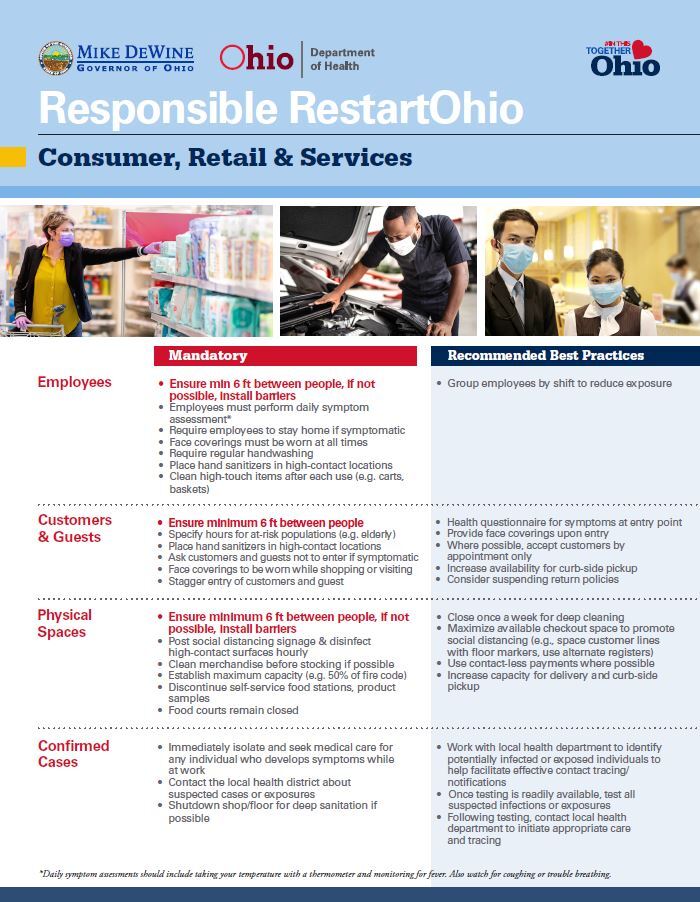COLUMBUS, Ohio — After weeks under a stay at home order, Gov. Mike DeWine has outlined a plan to gradually reopen Ohio while still focusing on slowing the spread of COVID-19.
DeWine outlined the first steps to reopening the state during his daily press conference Monday.
Steps to Reopening
The governor said the state needed to do two things for reopening the state to be considered: testing and tracing.
Ramped-up testing projections show that at the start of the expansion on April 29,there will be more than 7,000 daily tests able to be conducted. By May 27, the fifth week of the planned testing expansion, more than 22,000 daily tests will be able to be conducted, DeWine said.
As for tracing, a workforce plan has been created by the state to gather volunteers and workers to help conduct the tracing of the virus over a long period of time. The first tier of the plan started with volunteers that have helped health departments across the state.
Because the need for people to help trace the virus is so high, a second and third tier have been planned with the second tier gathering funding to pay locally hired workers and the third tier creating a deployable pool of hired state employees to help track the virus, with around 1,750 workers on hand, according to DeWine.
May 1
DeWine said he knows there has been speculation on when the state will reopen, but that the most important thing isn’t when but how, which is a gradual reopening. Beginning May 1, all health procedures and operations that do not require overnight stay in a hospital can continue to move forward, according to an order issued by DeWine.
Under the previous order on March 17, elective procedures were banned.
Veterinary and dental services are included under the new order, DeWine said.
The governor said that under the previous order, the number of visits to the hospital and doctors offices had slowed down and many people were missing important visits out of fear of the virus.
May 4
Under the new order, general offices and manufacturing, distribution and construction companies will be allowed to reopen if they had been closed under the original stay at home order.
All companies who are now able to open or had been open before must follow the following guidelines:
- Require face masks or covering for all employees and clients and customers
- Conduct daily health assessments of employees and employers
- Maintain good hygiene, social distancing and hand washing
- Clean and sanitize workplaces often
- Maintain social distancing practices of 6-feet between people, use barriers when 6-feet of distance is not possible, establish maximum capacity to 50% of fire code

While general offices are able to reopen, the governor asked that, when possible, employees remain working from home. Lt. Gov. Jon Husted suggested employers work to phase employees back into the workplace in a logical, safe way, including phasing in high-risk employees back into the workplace last.

May 12
Under the new order, retail, service and consumer businesses will be allowed to reopen, DeWine said.
All employees and guests will be required to wear face masks or coverings while working at or visiting these places of business.

Stay at home order
DeWine said the stay at home order is still in place but is modified to allow the reopening of the economy.
Gatherings of 10 people or more are still not allowed with the modifications of the stay at home order, DeWine said.
Businesses not listed in the plan
While some businesses received a date to reopen, many other business sectors did not, including dine-in restaurants, hair salons, gyms and day cares.
Here is a full list of businesses that remain closed:
- K-12 schools
- Restaurants and bars (carry-out and delivery services permitted)
- Personal appearance/beauty services
- Includes hair salons, day spas, nail salons, barber shops, tattoo parlors, body piercing locations, tanning facilities, massage therapy locations and similar businesses.
- Older adult day care services and senior centers.
- Adult day support or vocational habilitation services in congregate settings.
- Rooming and boarding houses, and workers’ camps.
- Entertainment/recreation/gymnasium sites.
- Includes, but is not limited to:
- All places of public amusement, whether indoors or outdoors, such as:
- Laser tag facilities, roller skating rinks, ice skating rinks, arcades, indoor miniature golf facilities, bowling alleys, indoor trampoline parks, indoor water parks, arcades, and adult and child skill or chance game facilities remain closed.
- Gambling industries.
- Auditoriums, stadiums, arenas.
- Movie theaters, performance theatres, and concert and music halls
- Public recreation centers and indoor sports facilities.
- Parades, fairs, festivals, and carnivals.
- Amusement parks, theme parks, outdoor water parks, children's play centers, playgrounds, and funplexes.
- Aquariums, zoos, museums, historical sites, and similar institutions.
- Country clubs and social clubs.
- Spectator sports, recreational sports tournaments and organized recreational sports leagues.
- Health clubs, fitness centers, workout facilities, gyms, and yoga studios.
- Swimming pools, whether public or private, except swimming pools for single households.
- Residential and day camps.
- Campgrounds, including recreational camps and recreational vehicle (RV) parks. (Excludes people living in campground RVs with no other viable place of residence as well as people living in cabins, mobile homes, or other fixed structures that are meant for single families and where preexisting residential activity already has been established. (E.g., for people who have part-time preestablished residences at campgrounds for the summer months.)
These types of businesses, while very important, are a hard environment to control the virus in and the state is starting with the easiest areas to control, DeWine said.While they will not be opening under the first wave of reopening, as long as the numbers continue to stay low, more businesses may be considered to reopen at a later time, DeWine said.
We know there is a great desire to get restaurants fully open and to get hair salons and daycares open -- but we must first start down the pathway of opening things up where we thought there was less risk and a more controllable risk.
— Governor Mike DeWine (@GovMikeDeWine) April 27, 2020
Rules for customers and enforcement
Under the reopening, the following guidelines have been listed as mandatory for customers and guests of retail and service businesses:
- Ensure minimum 6 ft between people
- Specify hours for at-risk populations (e.g. elderly)
- Place hand sanitizers in high-contact locations
- Ask customers and guests not to enter if symptomatic
- Face coverings to be worn while shopping or visiting
- Stagger entry of customers and guests
- The following guidelines have been listed as "best practices" recommended for customers and guests of retail and service businesses:
- Health questionnaire for symptoms at entry point
- Provide face coverings upon entry
- Where possible, accept customers by appointment only
- Increase availability for curb-side pickup
- Consider suspending return policies
DeWine said that while these guidelines can be enforced by health officials and law enforcement, be believes that won't be widely necessary as Ohioans will hold themselves and others accountable.
Personal protective equipment is still not as available as the state needs but the state said it is working to get more.
The coronavirus is still here and is as dangerous as it’s ever been, DeWine said, but the actions taken by Ohioans to slow the spread so far has made a plan to reopen the state possible. He said social distancing, washing hands, sanitizing areas and wearing a face mask remain crucial for the plan to be successful.
DeWine said Ohio is capable of doing two things at once—controlling COVID-19 and keeping the economy going—which is the essence of his plan for the state.
Additional Coronavirus information and resources:
Read our daily Coronavirus Live Blog for the latest updates and news on coronavirus.
We're Open! Northeast Ohio is place created by News 5 to open us up to new ways of thinking, new ways of gathering and new ways of supporting each other.
Click here for a page with resources including a COVID-19 overview from the CDC, details on cases in Ohio, a timeline of Governor Mike DeWine's orders since the outbreak, coronavirus' impact on Northeast Ohio, and link to more information from the Ohio Department of Health, the Cuyahoga County Board of Health, the CDC and the WHO.
See data visualizations showing the impact of coronavirus in Ohio, including county-by-county maps, charts showing the spread of the disease, and more.
The federal government has begun distributing $1,200 Economic Impact Payments to millions of Americans to help relieve the economic burden caused by coronavirus. Click here for everything you need to know about checking the status and receiving these payments.
The CDC and the Ohio Department of Health are now recommending the use of cloth face coverings in public to slow the spread of COVID-19.
Read more about the CDC's recommendation here. Here is a step-by-step guide on how to make a face mask from common household materials, without having to know how to sew.
View a global coronavirus tracker with data from Johns Hopkins University.
Here is everything you need to know about testing for coronavirus in Ohio.
Here's a list of things in Northeast Ohio closed due to coronavirus concerns
See complete coverage on our Coronavirus Continuing Coverage page.




